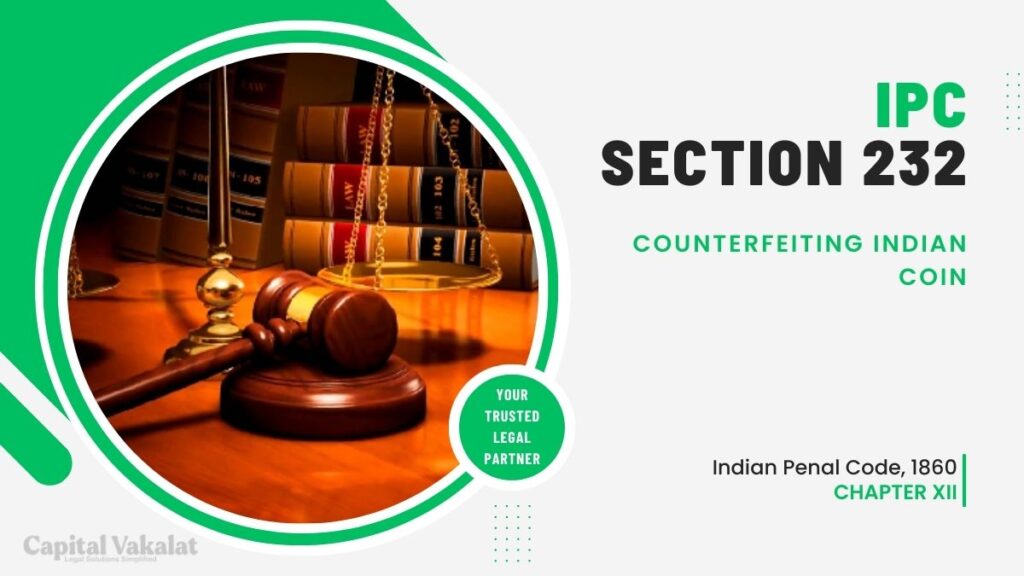Counterfeiting Indian currency is not a new phenomenon; it has existed for centuries, plaguing economies and creating confusion among citizens. The act of counterfeiting is not just illegal but also poses significant threats to the economic stability and trust within a nation. In India, the offense of counterfeiting Indian coins is addressed under Section 232 of the Indian Penal Code (IPC).

This article delves into the depths of Section 232 IPC, examining the legal provisions, historical context, impact, and preventive measures surrounding counterfeiting Indian coin.
The Offense of Counterfeiting Indian Coin
Understanding the Concept of Counterfeiting
Counterfeiting is the act of replicating or imitating a genuine coin or currency note with the intention to deceive and pass it off as genuine. This illegal practice has been a constant challenge for both authorities and the public.
Historical Context of Counterfeit Currency
Counterfeiting dates back to ancient civilizations when counterfeiters would create imitation coins to defraud the public. The evolution of counterfeiting techniques and the history of such practices in India provide an interesting backdrop to the modern situation.
The Impact of Counterfeit Currency on the Economy
Counterfeit currency poses a significant threat to the economy, as it can undermine the value of genuine currency, reduce trust in financial systems, and lead to inflation.
Section 232 IPC: A Detailed Overview
The Legal Provisions of Section 232 IPC
Section 232 IPC specifically deals with the offense of counterfeiting Indian coin. It defines the various acts that constitute the offense and the legal consequences associated with it.
Punishments and Penalties Associated with Counterfeiting Indian Coins
Understanding the severity of the punishment for this offense is crucial. Section 232 IPC outlines the penalties that can be imposed on individuals involved in counterfeiting activities.
Investigation and Prosecution
How Counterfeiting Cases Are Investigated
Investigating counterfeit currency cases involves a meticulous process that includes the collection of evidence, forensic analysis, and the cooperation of multiple agencies.
The Role of Law Enforcement Agencies
Law enforcement agencies, such as the police and the Reserve Bank of India, play a pivotal role in combating counterfeiting. Their cooperation and vigilance are essential in identifying and apprehending counterfeiters.
Preventive Measures
Steps Taken by the Government to Curb Counterfeiting
The Indian government has taken numerous steps to prevent the counterfeiting of Indian currency. These measures include the introduction of advanced security features and the development of currency notes and coins that are difficult to replicate.
Security Features on Indian Currency
Indian currency is equipped with several security features, ranging from watermarks to holograms, which make it challenging for counterfeiters to produce fake currency.
Counterfeit Detection Methods
How to Identify Counterfeit Indian Coins
Recognizing counterfeit coins is vital to prevent their circulation. This section discusses the telltale signs that can help individuals identify fake coins.
Technology and Tools Used for Detection
The utilization of technology and specialized tools is essential for banks, businesses, and individuals to detect counterfeit Indian coins.
Historical Cases and Impact
Notable Instances of Counterfeiting in India
This section explores historical cases of counterfeiting in India, shedding light on the audacity and creativity of counterfeiters.
Economic and Social Consequences
The consequences of counterfeiting extend beyond financial losses; they impact the social fabric of the nation. Understanding these consequences can help raise awareness.
Challenges in Combating Counterfeiting
Evolving Techniques Used by Counterfeiters
Counterfeiters constantly adapt to new technologies and methods. This section discusses the ever-evolving challenges faced by authorities.
International Dimensions of Counterfeiting
Counterfeiting is not confined within national borders. International cooperation is crucial in addressing the global nature of this crime.
Public Awareness and Education
The Role of Citizens in Preventing Counterfeiting
Every citizen has a role to play in preventing counterfeiting. Being vigilant and informed can help thwart counterfeiters’ attempts.
Educational Programs and Campaigns
Various government and non-government organizations conduct awareness campaigns and educational programs to educate the public about counterfeit currency and its consequences.
Conclusion
In conclusion, Section 232 IPC stands as a robust legal provision aimed at curbing the offense of counterfeiting Indian coins. Its enforcement is essential to maintain the integrity of the Indian currency and the financial stability of the nation.
Frequently Asked Questions
What are the common security features on Indian currency notes and coins?
Indian currency features security elements like watermarks, security threads, latent images, and more, which make counterfeiting difficult.
What is the punishment for counterfeiting Indian coins according to Section 232 IPC?
Section 232 IPC prescribes severe penalties, including imprisonment, for individuals involved in counterfeiting Indian coins.
Are there any recent technological advancements in counterfeit detection?
Yes, technology has significantly advanced counterfeit detection methods, making it easier for individuals and institutions to spot fake currency.
How can I contribute to preventing counterfeiting in my community?
Vigilance, awareness, and promptly reporting suspected counterfeit currency are ways individuals can contribute to preventing counterfeiting in their communities.